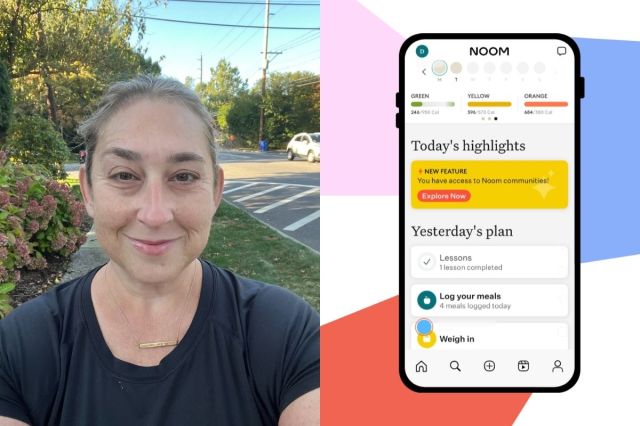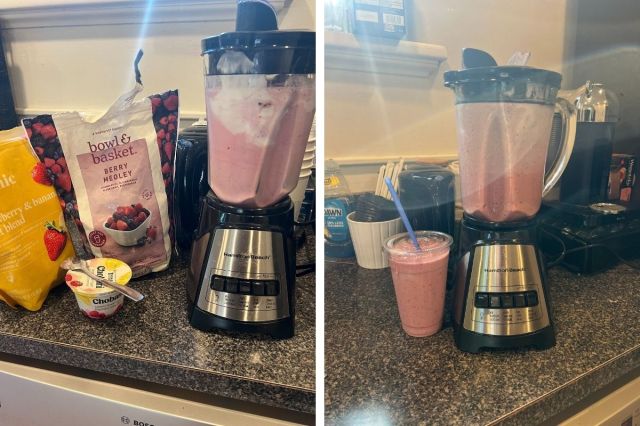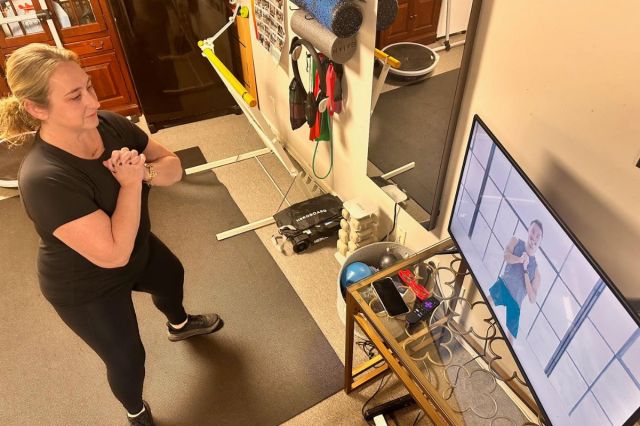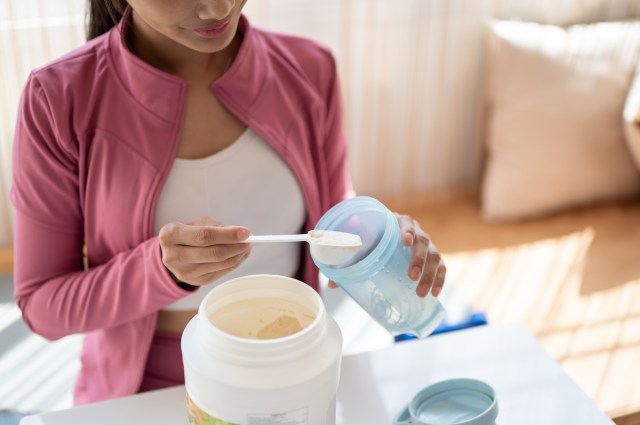When I started taking a GLP-1 medication in October 2023, I had one goal: lose a lot of weight. Now, almost two years later, I’m 50 pounds lighter. After a lifetime of yo-yo diets and exercise classes, I was relieved that this weight loss came with very little thought, effort, or deprivation — all it took was a weekly injection.
The process has been, dare I say, easy — but I had questions: Should I be more proactive in the process? How can I build strength and preserve muscle as I continue to lose weight? Am I getting enough protein — or the right nutrients at all — as my appetite changes on the medication? And, because the number on the scale remained unchanged for a few months, I wondered if there was something I could do to continue progressing.
For me, the weight loss was no longer the finish line — it was the starting point for the next phase. I didn’t just want to be lighter; I wanted to be stronger, more energetic, and confident that I could keep this up for good. That’s what led me to Noom.
I wasn’t looking for another fad diet that would make me give up my favorite foods. I wanted structure, accountability, and guidance. I wanted an affordable way to learn how to fuel my body better, train to make smarter choices more intrinsically, and feel in control as I continued my weight-loss journey. So, I gave Noom a try — and after testing, I can see the benefits of pairing its app and systems with your GLP-1 use, even if you aren’t prescribed one through Noom (which they do offer).
(Through Noom, GLP-1s start at $99 – no insurance required. If that’s not right for you — for whatever reason — you can always sign up for Noom’s accompanying Weight Loss app, which we review below.)

Signing Up Is Surprisingly Simple
From the start, the sign-up process felt personal. Instead of simply asking for my current height and weight to establish a target to build my plan around, it walked me through a thoughtful questionnaire that homed in on my habits, mindset, and motivations — knowing that eating entails so much more than just hunger. It asked questions like: “What’s your goal? Is it to lose weight, improve your energy, or be more active? How motivated are you feeling? Does your motivation ebb and flow? Does it stay consistent? Are you active? Do you sit all day, or are you on your feet? Are you on a weight-loss medication? And, if so, which one? Is there anything else you want to explore? (i.e., healthy aging, stress reduction, emotional well-being, or digestion)”
The quiz took about five-ish minutes to complete, and it immediately made the program feel tailored to me. Instead of a generic plan, Noom was crafting a holistic roadmap that fit my personality, my preferences, and my real life.
After finishing the quiz, Noom showed me a projected weight-loss timeline based on the goal weight I provided earlier. It set a daily calorie target and asked how much time I could realistically commit each day to working out. (Even five minutes counts). That detail made the process feel approachable and encouraging instead of overwhelming or unnecessarily critical. Plus, because I’m on a GLP-1, I was able to opt into Noom’s GLP-1 Companion program, a specialized version of the plan tailored to using these medications. It emphasizes things like hitting your protein goals, protecting and strengthening muscle, and building healthy habits while the medication does its work. For those not on a GLP-1 but are considering it, Noom recently launched Noom Med, a personalized health care program combining both solutions: a medical aid like Noom’s GLP-1 Program, along with behavior change support, the Noom GLP-1 Companion with Muscle Defense.

It Works From Day One
During the first week, I was impressed by how motivating and easy to follow Noom was. Each morning, I opened the app and read the quick lessons, which are one- to two-minute articles — you can adjust the time spent to your preference — that cover everything from nutrition basics and how-tos to habit-building strategies and mindset shifts. They’re short but surprisingly eye-opening, even for a lifelong dieter.
I used the app to track my food — I’m not great at adding everything; I’m a work in progress — and I liked that after entering my meals, the app provided a breakdown of the calories and protein consumed and used a color-coded food system to help me see patterns at a glance: Green foods (lean proteins, veggies, whole grains) are lowest in calorie density. Yellow foods (red meats, starches) are higher in calories but should still be eaten in moderation. Orange foods (highly processed foods and dessert dishes) are the most calorie-dense and contain few healthy nutrients.
Nothing was off-limits, which made the whole process feel supportive instead of restrictive. Because my diet focuses on protein right now, I loved being able to see how many grams I’d consumed and how many more I needed for the day.
I could also track my water intake and my mood, and I linked Noom to my iPhone’s Health app so that I could track my daily activity as well — even small bursts of movement (like walks or quick stretches) count. After just a week, I was already more aware of my activity and more intentional about staying active. The app offers a list of weekly commitments meant to help you form new habits or make changes in your routine. Think: This week I’ll walk 30,000 steps,” or “This week I’ll add a green food to every meal.” I chose: “This week I’ll replace my snacks with water,” and I did so nine times out of 10.
It’s Not “All or Nothing”
What stands out still, even now that my program is well underway, is how positive the whole experience feels. The tone is upbeat, the steps are doable, and the focus is on progress — not perfection.
It’s easy to fall into “all or nothing” thinking during weight loss, especially after a big transformation like mine, but Noom is helping me break that mindset and adopt a healthier outlook. The app encourages curiosity about my choices instead of guilt, and that’s exactly the shift I needed.
And I’m clearly not alone. There’s a community feature that lets you connect with others who are going through the same process. Reading other people’s small victories made me feel less alone and more inspired to keep showing up.

It’s There to Help You Keep Going
After 14 days of using Noom, I reflected and felt optimistic about what was ahead. I haven’t had a dramatic transformation; I’m not suddenly a totally new person who craves the gym at 6 a.m.; I haven’t stopped eating cookies. What has changed, though, is that I’m slowly building habits that feel sustainable. After years of yo-yo dieting and obsessing over the number on the scale, that feels like a win.
One thing I wanted to work on when I started Noom was movement. I lost 50 pounds on my GLP-1 journey without any real exercise. Still, one of my goals with Noom was to get help integrating physical activity into my daily routine without feeling overwhelmed. I still haven’t made it to the gym, but I’ve been walking outside most days. As I mentioned earlier, I connected Noom to my iPhone’s Health app, so it tracks my daily steps automatically. Walking has always been the kind of movement that doesn’t feel like a chore, and Noom has helped me feel accomplished with whatever I do get in — whether it’s a quick walk with my dog or a longer one with a friend. Instead of pushing intense workouts or rigid expectations, the app celebrates the daily goal of 2,000 steps. Even though I often exceed 10,000 steps, on days when I only hit 2,000, I still feel like I’ve accomplished something.
It Offers Guilt-Free Encouragement
That’s been the most significant difference for me with Noom so far: it keeps me accountable without making me feel anxious or guilty. There were definitely days I didn’t log any food and days I fell short of my step goal. When I came back to the app, there was no guilt trip waiting — no pushy notifications demanding I return or to maintain a streak. It simply picked up where I left off. That might sound small, but it makes consistency feel realistic — and new habits less of a prescription.
Noom also exposed my protein intake. I had no idea how hard it actually is to get enough in a day. I thought I was doing fine — a couple of eggs here, some chicken at dinner, a yogurt as a snack — but once I started logging, I saw I was falling short. One day, I logged what I thought was a healthy day of eating, and I was still 40 grams under my target. That’s when I found Noom’s high-protein food list, among other lists, in the app. It breaks down exactly how much protein is in the most common foods and color codes them based on the green, yellow, and orange food lists, so you know which ones are the better choices. Now, I’m more intentional about it, even if I still don’t reach my goal — I’ll add cottage cheese to my breakfast, choose tuna or turkey for lunch, or sprinkle roast chickpeas on a salad. They’re small changes, but they add up.
I still have progress ahead of me, and up next is trying some of the app’s more than 3,000 recipes and myriad movement classes.

It Gets You Results — Even When You’ve Stalled
One of the things I’ve been loving most about Noom is how it personalizes everything to my own pace. The more I move, the more my goals adapt. When I first started, my daily step target was 2,000, but as I’ve kept up my walks, the app gradually raised it — now I’m hitting 3,500 a day. I also earn extra calories when I burn more than usual, which makes the process feel flexible and encouraging. It’s not just working with me — it’s working for me: As I mentioned when I first started, weight loss is no longer my finish line, and it’s definitely not my primary focus. But before I joined Noom, my progress had stalled, and I’m thrilled to say the scale has started to move again.
It Offers Practical Solutions to GLP-1 Side Effects
The app has also been a big help in managing some of my GLP-1 medication’s side effects. Throughout my journey, I’ve struggled with heartburn and random bouts of nausea. My go-to has always been Pepcid, but there are only so many you can take in a day.
In the “Manage Your Side Effects” section under Noom’s Success Kit, you can click on each common symptom — indigestion, constipation, headaches, fatigue, and more — and get practical, easy-to-implement tips. A few that have worked well for me include sipping ginger tea when I’m feeling queasy, taking a short walk after meals when heartburn hits, and staying hydrated throughout the day to ease constipation. Small, simple changes — but they’ve really made a difference.
It Helps You Build Better Habits for the Long Run
This month, I planned to focus on Noom’s recipes and workout classes. I started the first of 10 weight-free workouts (each under 25 minutes) in the Beginner Muscle Defense program and made a delicious butternut squash soup I found through the app’s recipe search.
One night, I got sidetracked and ended up deep-diving into a section I hadn’t realized would be so helpful. Because Noom emphasizes managing emotions that can lead to overeating, I began exploring the meditations in the Create Inner Calm section. My favorite discovery? The one-minute meditation called Feel More Present. When I’m anxious or stressed — feelings that used to send me straight to a family-size bag of Ruffles — I press play, close my eyes, and follow the guided meditation. A few deep breaths later, and the calm sets in. And while I may not always have access to this particular meditation, it’s helping me get into the habit of turning to it, not food, when I feel stressed.
This story was paid for by an advertiser. No members of the Better Report’s editorial staff were involved in the creation of this content.
Feature Image Credit: Inside Creative House/ Shutterstock








